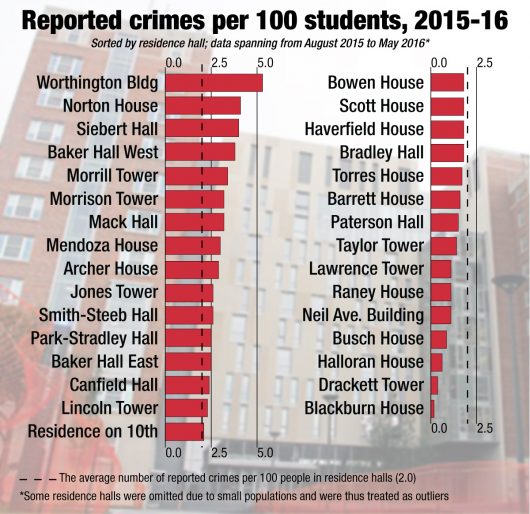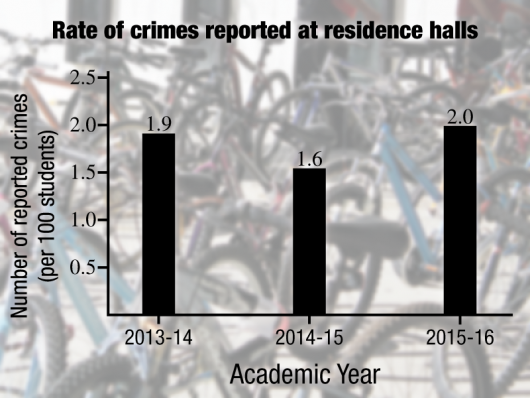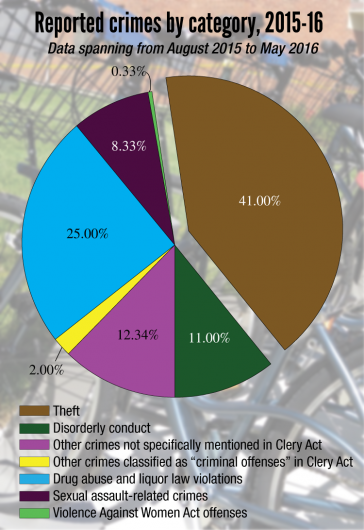[author image=”https://www.thelantern.com/files/2017/07/Amanda-Etchison-1sjc3d0.png” ]Amanda Etchison produced this content in her role as Patricia B Miller Reporter.[/author]

Credit: Robert Scarpinito | Managing Editor for Design
Katherine Arnold’s relief at having her bicycle pedal fixed was short-lived when, just a few days after the repair, she saw her lock hanging in place of her two-wheeled ride outside of Busch House.
“When I came out in the morning, (the bike) was gone and my bike lock was there and it had been clearly cut through,” said Arnold, a second-year in social work. “It definitely is an inconvenience, and it is kind of sad that we can’t leave our property at the bike racks outside of our residence halls and be confident that they’ll still be here in the morning.”
Arnold’s bike theft, which occurred in early October, happened on North Campus, but a Lantern analysis of three years of Ohio State Department of Public Safety crime log data shows that crime isn’t more likely to happen in any specific region of campus.
Although some residence halls were found to have a higher number of crimes reported per capita last year, data doesn’t show a trend in which residence halls consistently had more reported crimes.
OSU Administration and Planning spokesman Dan Hedman said many circumstances contribute to reported crime trends.
“When considering crime trends, one must look at all factors, including the number of total residents per building, location (inside/outside), nature of the crime and other factors,” Hedman said in an email.
Stereotypes versus statistics
Even though some residence halls and parts of campus have developed reputations for having populations that might be more social or prone to partying, The Lantern’s analysis shows that these locations do not necessarily have higher numbers of reported crimes.
Jennifer Welch, who lived in Siebert Hall on South Campus as a first-year, said she moved to Jones Tower on North Campus for her second year on campus. She said she expected a different atmosphere, especially after hearing the generalizations often used to describe both parts of campus.
“I had heard that there are way more parties and bars closer to South Campus,” said Welch, a second-year in accounting and Chinese. “And North Campus is more academically based, so I thought, ‘Hey, I am an academically focused person, so I want to be close to the quiet place.’”
For the 2015-16 school year, 16 residence halls had an intra-hall per capita rate of reported crime that was higher than the average rate for all of OSU’s residence halls.
The average number of reported crimes in all residence halls for last academic year was two crimes per 100 students living in OSU-owned housing.
The five residence halls that had the highest number of reported crimes per 100 students for academic year 2015-16 were:
-
Worthington Building (5.3 crimes reported per 100 students)
-
Norton House (4.1 crimes reported per 100 students)
-
Siebert Hall (4 crimes reported per 100 students)
-
Baker Hall West (3.8 crimes reported per 100 students)
-
Morrill Tower (3.4 crimes reported per 100 students)
At least one hall from each portion of campus — North, South and West — had more than two reported crimes per 100 students.
Hedman said the university takes “all types of crime very seriously.”
“The safety of our campus community is our number one priority and we continue to look for ways to address crime,” he said.
Breaking it down by building
Arnold, the second-year in social work, is not alone as a victim of bike theft.
Thefts accounted for 41 percent of crimes reported at OSU residence halls during the 2015-16 academic year, according to the data collected by The Lantern.
The second most commonly reported set of crimes at residence halls for 2015-16 was drug abuse and liquor law violations, which made up 25 percent of that year’s data.
Disorderly conduct accounted for 11 percent of reported crimes for 2015-16, and a little more than 8 percent of reported crimes were sexual assault-related incidents.
Other crimes considered “criminal offenses” in The Clery Act, such as aggravated robbery, arson and burglary, made up 2 percent of the reported crimes that academic year.
The Clery Act requires that colleges and universities that offer federal financial-aid programs make information regarding college campus crime more readily available by reporting crimes that occur on campus and, in some cases, around campus areas.
Miscellaneous crimes that are not specifically mentioned in The Clery Act — which range from breaking and entering to public urination — accounted for more than 12 percent of reported crimes.
Requests from The Lantern to interview employees at these individual residence halls were declined.

Credit: Robert Scarpinito | Managing Editor for Design
Worthington Building
Located on South Campus, Worthington Building houses approximately 130 students each year, according to data provided by the Office of Student Life. Lantern analysis shows that during academic year 2015-16, seven crimes were reported at this hall, which equates to 5.3 crimes per 100 students.
The most commonly reported crime was theft.
The seven crimes reported during academic year 2015-16 is an increase from the year prior, when only two crimes were reported — one for criminal damaging and one for theft. The per capita rate for reported crimes in 2014-15 was 1.5 crimes reported per 100 residents.
The per capita rate for academic year 2013-14 was 4.6 crimes reported per 100 students. This was also the highest per capita rate for a single residence hall that year.
Norton House
Of the seven crimes reported at Norton House during academic year 2015-16, five were theft-related incidents. The other reported crimes were one report of disorderly conduct and one report of menacing by stalking.
This North Campus residence hall houses approximately 170 students, and the per capita crime rate is 4.1 crimes reported per 100 students.
Norton House appears as one of the residence halls with the most reported crimes each academic year for the three years of data studied. During the 2014-15 academic year, it was the fifth-highest hall, with 3.2 crimes reported per 100 students. A year before that, its per capita rate was once again 4.1 reported crimes per 100 students.
Siebert Hall
Academic year 2015-16 marked the first year of the three years studied by The Lantern that Siebert Hall appeared as one of the residence halls with the highest reported crime rates.
The per capita reported crime rate for last year was 4.0 crimes reported per 100 students. The South Campus residence hall normally houses about 300 students each year.
The 12 crimes reported during academic year 2015-16 included five reports related to possession of drugs or underage alcohol consumption and three reports of theft.
Baker Hall West
Also located on South Campus, Baker Hall West houses about 415 students each year. Its per capita rate of reported crimes per 100 students was 3.8.
Of the 16 crimes, during academic year 2015-16, half were related to possession of drugs or drug paraphernalia. Other reports included four theft-related incidents.
Morrill Tower
Morrill Tower is located on West Campus and is home to approximately 1,230 students.
During academic year 2015-16, the per capita rate was 3.4 crimes reported per 100 students.
More than 40 percent of the 42 crimes reported were thefts.
Other reports included 12 reports of drug- or alcohol-related offenses, six reports of disorderly conduct and two reports of burglary.
Number of reports remains consistent
According to data provided by the Office of Student Life, a little fewer than 15,000 students live in OSU on-campus housing each academic year.
Based on this number, The Lantern found that the per-capita number of reported crimes in residence halls has remained relatively constant over the past three years.
The rate for academic year 2015-16, which was two crimes reported per 100 students living in OSU-owned housing, was a slight increase from the per capita rate of reported crimes in 2014-15, which was about 1.6 crimes reported per 100 students. In 2013-14, the per capita rate was approximately 1.9 crimes reported per 100 students.
Although the per capita number of reported crimes in residence halls remains constant, Hedman said the university has seen a decrease in reports of major on-campus crime for each calendar year since 2011.
According to data provided by the Office of Administration and Planning, overall campus crime from calendar year 2013 to 2015 has decreased by 219 reports.

Credit: Robert Scarpinito | Managing Editor for Design
Preventing crime
In addition to lists of safety tips provided to students in residence halls by the Office of Student Life, Hedman said the Department of Public Safety’s security division regularly patrols residence halls and surrounding areas seven days a week.
Students are encouraged to be vigilant in the residence halls by locking doors, keeping money and identification cards in a safe place and using a U-lock on bicycles, Hedman said. Students should not allow people they do not know to enter the residence halls, he added.
Hedman added that suspicious activity can be reported to University Police. Serial numbers of valuable items should be recorded so that this information can be included in police reports. Missing items should be reported to the police immediately.
Arnold said she has been working with University Police to file a report for her missing bike, which she estimated cost around $500.
Recently, she said, an officer contacted her to let her know that a camera caught the theft on video. Arnold added that she plans to pursue criminal charges and is now hoping for the bike’s return.
“I hope that they either find it or some form of retribution will come out of it,” she said. “Hopefully … if I do get it back, I am going to put it right back where it was. I just will use a U-lock and hope for a different result.”
Methodology
The Lantern created and analyzed a database of information recorded from the OSU Department of Public Safety’s online crime log, which provides information on crimes reported on campus in accordance with the 1998 Jeanne Clery Disclosure of Campus Security Policy and Campus Crime Statistics Act.
Data from academic years 2013-14, 2014-15 and 2015-16 was collected and logged in a spreadsheet, which documented the report number, incident date, incident type and location. Incidents that occurred at OSU residence halls, identified as buildings listed on the Office of Student Life’s University Housing website, from May through August of each academic year were recorded.
Per capita numbers of reported crimes in residence halls for the entire population of students living in on-campus residences were calculated by dividing the number of crimes reported in residence halls for each academic year by 14,865. This number was provided by the Office of Student Life as the estimated number of students who live in OSU residence halls each year.
Per capita numbers of reported crimes for individual residence halls were calculated by dividing the number of crimes reported in a specific hall by the estimated number of students who live in that hall. Figures pertaining to residence hall populations were also provided by the Office of Student Life.
Some residence halls with populations fewer than 100 students were omitted from comparison due to their small numbers, which resulted in greatly skewed per capita crime numbers. These crimes were still incorporated into the general per capita calculations, as well as the breakdown of type of crime each year.
In an effort to protect the privacy of victims of sexual assault-related crimes, The Lantern did not list cases of sexual assault, sexual imposition, rape or sexual battery for individual halls. These numbers were still incorporated into the general calculations and crime breakdowns.
Residence hall names are based on the names provided by the Office of Student Life. All attempts were made to keep hall names consistent throughout the analysis, taking into consideration renaming of halls following the North Residential District Projects.
This article was made possible by the generosity of The Lantern and Ohio State alumna Patty Miller.


